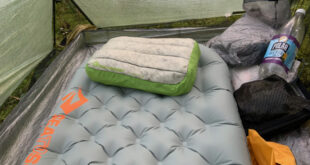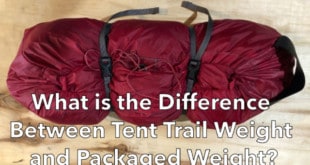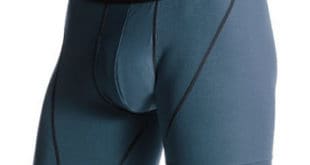Selecting a comfortable tent site is a useful skill for all backpackers, regardless of whether you set up camp in a designated camping area or if you stealth camp in a natural, unprepared site. Here are some of the things that I …
Read More »Frequently Asked Questions
Why do Waterproof/Breathable Rain Jackets Wet Out?
The biggest dirty little secret in the outdoor industry is that waterproof/breathable rain jackets won’t keep you dry and will wet out. It doesn’t matter if you buy a high-end $450 Arcteryx Gore-tex Parka or wear your bathrobe, they’ll both Wet Out …
Read More »Do You Need a Pillow for Backpacking?
If you use a pillow at home, I recommend taking a camping pillow with you on your backpacking trips. You’ll almost certainly sleep better if you have one because your body is used to having the extra support. I learned this the …
Read More »Top Lid Backpacks vs Roll-Top Packs: Which is Better and for What?
Most overnight and multi-day backpacks have either a top lid pocket or a roll-top closure. Both are perfectly fine for backpacking and which you choose has a lot to do with your personal preferences, packing style, and the type and quantity of …
Read More »When Lightning Strikes Your Trekking Umbrella…
Can a trekking umbrella protect you against lightning? No. Lightning is attracted to the highest thing around. So if you’re in an open field and you open an umbrella above your head, there is a higher risk that lighting will hit you. …
Read More »What is the Difference between Tent Trail Weight and Packaged Weight?
Trail weight is the weight of a tent with just the fly, the inner tent, pre-attached guylines, and the tent poles minus the tent stakes, stuff sacks, extra guylines, and repair kit if one is included with your tent. Packaged weight is …
Read More »Leukotape Blister Prevention Tape for Running and Hiking
Leukotape P Sports Tape is a sticky blister prevention tape with a strong zinc oxide adhesive that won’t come off, even in very wet conditions. It’s also highly breathable, so it can be safely worn by runners and backpackers for several days …
Read More »Water Bottle Insulation for Winter Hiking
An insulated water bottle sleeve is one of the ways you can keep your water from freezing on a winter hike. Most are designed to fit 32 oz (1 liter) bottles, including wide-mouth Nalgene bottles, which are better for winter use because …
Read More »How Many Pairs of Underwear Do You Bring on a Backpacking Trip?
How many pairs of underwear do you take when backpacking? While some people (like myself) only bring one pair, no matter the length of the trip, most SectionHiker readers bring two pairs on multi-day trips, one to wear, and one to wash …
Read More »Lightweight Backpacking: What is the Big 4?
The goal of lightweight backpacking is to reduce the amount of gear weight you carry on backpacking trips without compromising on comfort and safety. The best way to approach this is to weigh your existing gear on a postal or kitchen scale …
Read More »What to Wear for a Day Hike
Day hiking is a great way to get some fresh air, exercise every muscle in your body, and spend quality time with friends or family. Wearing the right clothing for a hike will help keep you comfortable and safe, so you can …
Read More »When are hiking boots better than trail runners?
Trail runners are all the rage in the hiking and backpacking community, but there are times when hiking boots really are better than trail runners. If you’re on the fence about whether to switch to trail runners or use them, take the …
Read More »Cold-Soak No-Cook Backpacking Meals 101
The terms “cold-soak” and “no-cook” have become popular lingo amongst backpackers who opt for another way to eat on-trail without using a stove. Cold-soaking is a no-cook method where you simply soak dry food with water to prepare a meal. Sounds easy, …
Read More »Winter Hiking Boots FAQ
There are three kinds of winter boots: insulated winter hiking boots, mountaineering boots, and pac boots. Which kind of winter hiking boot is right for you? Here’s a detailed guide that explains the differences between these so you can pick the right …
Read More » SectionHiker.com Backpacking Gear Reviews and FAQs
SectionHiker.com Backpacking Gear Reviews and FAQs 












